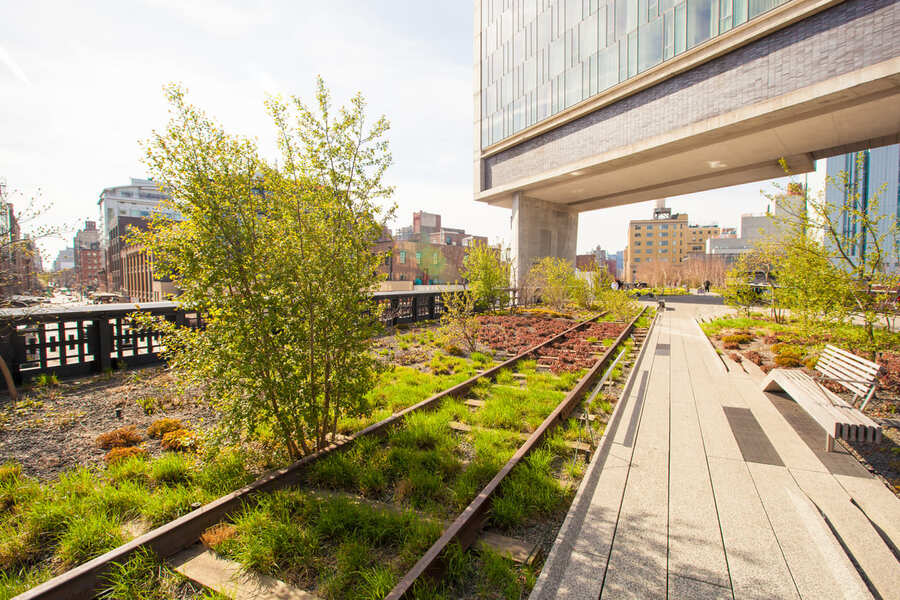One of the main challenges of sustainable urbanism is to take advantage of the positive aspects of traditional urbanism to evolve them under criteria that embrace the three pillars of sustainability: society, economy and environment.
This is necessary because we are at a point of breakthrough that forces us to rethink the principles by which we evaluate proposals that affect the fabric of our cities. Both users and all actors involved in urban planning and development must be involved in this.
What is sustainable urban development?
An urban development is defined as sustainable when strategies from all three dimensions of sustainability have been incorporated into its design and planning: social, economic, and environmental.
Currently, the cities in which we live, work, and interact have generally not been designed to face the challenges we encounter. They have become major generators of Greenhouse Gases (GHG) and have not been planned to optimise the quality of life of citizens in their daily lives.
Cities of the future must transcend traditional ideas and enhance both the existing fabric and new developments. In this way, sustainable urbanism is achieved.

Objectives and benefits of sustainable urbanism
Sustainable urbanism pursues 3 main objectives, which simultaneously act as benefits for the environment and people:
- Social Studies
Raising the standard of living and quality of life for all residents is one of the main objectives of sustainable urbanism. Cities must equitably address the needs of all people, regardless of gender, ethnicity, socio-cultural and economic status.
Socio-economic and demographic conditions must be assessed to make improvements that support social equity, public health, affordability and community participation.
- Economical
Through sustainable urban development, we add value to assets and land, attracting investors. This helps to prevent the decline of development.
On the other hand, it increases performance at work, as people are much more efficient when they are in good health and their place of employment is accessible. Through walking or biking tours, without the stress of major traffic jams or overcrowded public transport.
In addition, with greater control of the development process, thanks to the Smart City measures, operating and maintenance costs are significantly reduced.

- Environmental
Cities cover approximately 0.5-2.7% of the world's land surface, but could account for up to 70% of the world's anthropogenic GHG emissions. Cities consume a significant amount of fossil fuels in several sectors: transport, industry, waste and buildings.
The transport sector is responsible for 25% of global energy-related greenhouse gas emissions. The use of land is the key driver of mobility in a city, and rapid urbanization has led to uncontrolled urban sprawl and greater dependence on personal motorized vehicles. Through sustainable urbanism, we turn this around: we make the city for the pedestrian and not for the car.
In addition, cities are major producers of waste and consumers of materials, which represents a major depletion of natural resources. Sustainable urbanism provides opportunities to drive a global transition from a linear economy to a circular one. In this model, a product, material, or service does not become waste over time, but rather begins a new life cycle as a resource.
On the other hand, water demand has been steadily increasing in urban and peri-urban areas and is depleting freshwater reserves. Applying sustainable urban criteria reduces the consumption of this valuable resource and reconnects it with ecosystems. Thus, we increase their resilience, and cities can withstand and recover from episodic floods, droughts, wildfires, and other events.
How do we achieve sustainable urban development?
Sustainable urban development must be based on a holistic analysis from the initial planning and design phases to incorporate sustainability measures in various areas. Some of them are:
- Water: Reinfiltration into the ground through SUDS, use of rainwater for irrigation, monitoring of water consumption through smart meters…
- Energy: Efficient lighting, efficient pumps, monitoring of energy consumption through smart meters, installation of renewable energies…
- Transport: Municipal bicycle network, bicycle lanes with bike racks, charging points for electric vehicles, carsharing and motosharing car parks, public bus, metro and tram lines, full pedestrian accessibility…
- Materials: Use local, recycled, and/or recyclable materials that have complete traceability of their supply and procurement system, and their environmental impact.
- Ecology: Native vegetation with low water requirements, creation of biotopes for flora and fauna, recovery of endangered species…
- Waste: Recycling systems, clean points, composting systems for pruning and gardening waste…
- Health: Measurement of air quality, prevention of noise pollution, reduction of lighting pollution, installation of outdoor exercise areas, planting of urban vegetable gardens, installation of children's play areas, minimisation of the Urban Heat Island (UHI), etc
Urbanism in sustainability certifications
Sustainability certifications are currently the most comprehensive tool available for sustainability assessment of an urban development. All of them incorporate a certification scheme adapted to urban planning, such as:
- LEED v4.1 for Cities and Communities
- DGNB Districts v.2020
- BREEAM Urbanism 2020
- VERDE DU Polygons (logistics parks)
One of the most representative projects in terms of sustainable urban planning efforts is the Logistik City Green Life. This is the first urban development with LEED Platinum Pre-Certification in Spain, a project for which we have been entrusted with the management of the certification.
As we have seen, how we plan the urban layout directly affects human health, the management of economic resources, and our relationship with the environment. By gradually applying the guidelines of sustainable urbanism, our cities will substantially improve people's quality of life.


